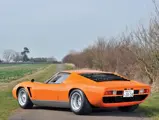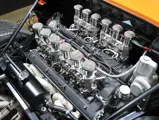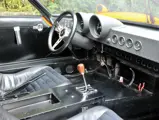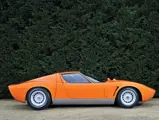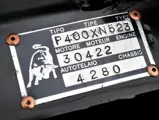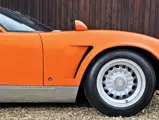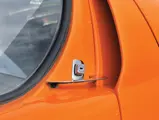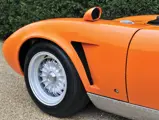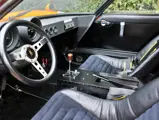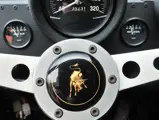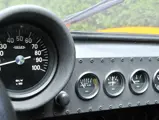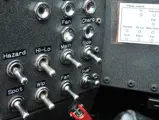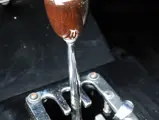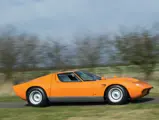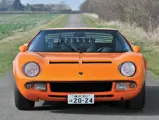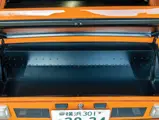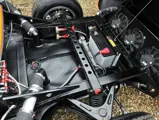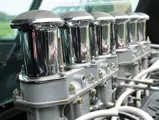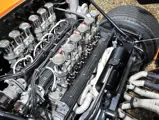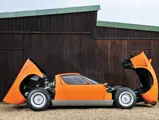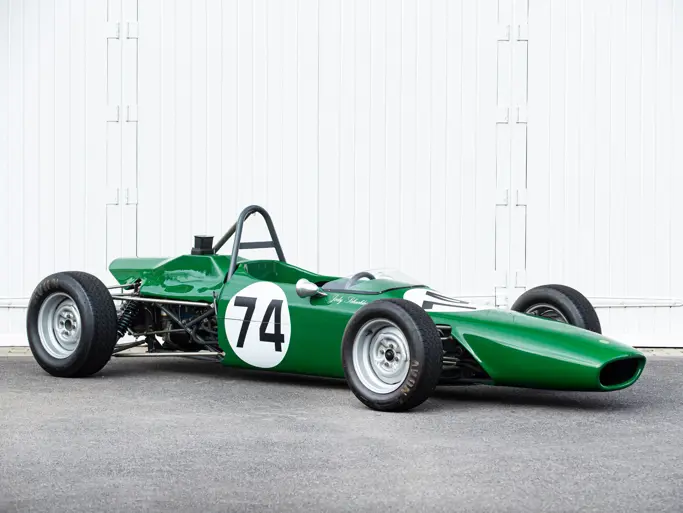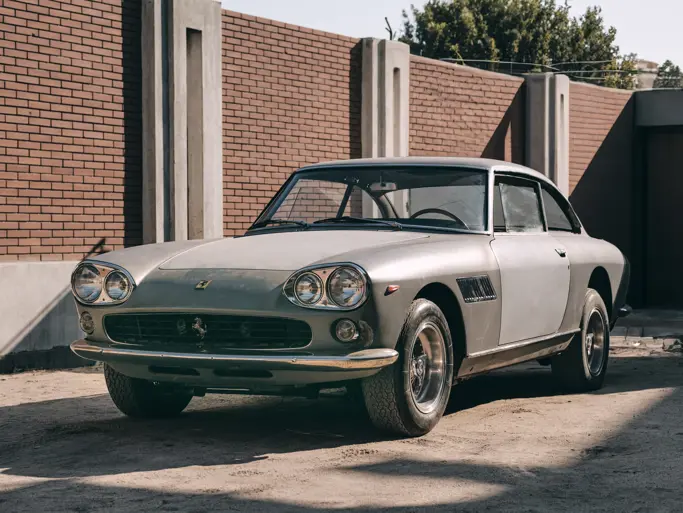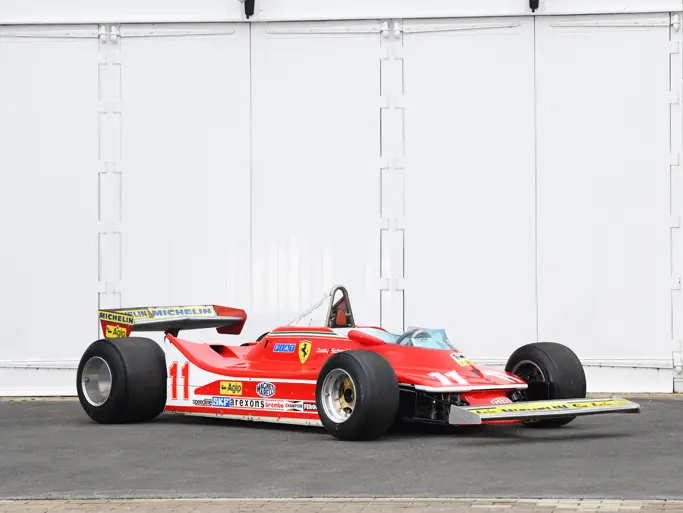Monaco 2014
1969 Lamborghini Miura S 'Jota'
{{lr.item.text}}
€448,000 EUR | Sold
 | Monte Carlo, Monaco
| Monte Carlo, Monaco
{{internetCurrentBid}}
{{internetTimeLeft}}

- A Lamborghini Miura S that has been upgraded to Jota specification
- Fitted with an original Miura SV engine
- Une Lamborghini Miura S qui a été portée aux spécifications Jota
- Équipée d'un authentique moteur de Miura SV
385 bhp, 3,929 cc mid-engined transversely mounted DOHC V-12 with four Weber carburettors, five-speed manual transmission, independent front and rear suspension with coil springs and telescopic shock absorbers, and four-wheel ventilated disc brakes. Wheelbase: 2,500 mm
Moteur V-12 transversal, 3 929 cm3, 385 ch, deux ACT par banc, quatre carburateurs Weber, boîte manuelle cinq rapports, suspension avant et arrière indépendante avec ressorts hélicoïdaux et amortisseurs télescopiques, freins à disque ventilé sur les quatre roues. Empattement: 2 500 mm.
To many, the Lamborghini Miura is unquestionably the world’s first supercar. Upon its introduction, the Miura pushed the boundaries of what was thought to be possible in designing an automobile. Not only did it push the envelope of performance, but it also pushed the envelope of automobile aesthetics, and it remains one of the most celebrated and instantly recognisable automotive shapes to this day. The Miura’s sensuous form captivated the crowd at its unveiling at the 1966 Geneva Salon, and that same design would remain largely unchanged until the last Miura left the production line of Lamborghini’s Sant’Agata factory. The world had never seen all those aspects combined into such an incredible package, and because of it, Lamborghini became a household name almost overnight. Everyone wanted one, but only captains of industry, heads of state, and rock stars could afford to put one in their garage.
Despite its world-beating performance, the Miura was never intended to be more than a road-legal rocket ship available to paying customers. However, the late factory test driver Bob Wallace believed that the Miura could be something more. Wallace dreamed of building a more focused Miura, one that took the production model to another level by decreasing weight and increasing horsepower. Since Ferruccio Lamborghini did not want to channel his company’s efforts into racing, Wallace was left to his own devices to build such an automobile. Left with one chassis to experiment with, Wallace decided to aim for designing a competition car that would fit into the FIA’s Appendix J.
In order to achieve this, Wallace focused on decreasing weight and achieving a better weight distribution for the car. Everything that could be discarded was, leaving a completely bare-bones interior, a single windshield wiper, fixed headlights, and Plexiglas windows. The gas tanks were repositioned from the Miura’s nose to the sills, and its spare tyre was relocated behind the engine. Additionally, Wallace utilised all the upgrades that were featured in the 1971 SV, including a more rigid chassis, a wider rear track with larger suspension wishbones, and a split-sump lubrication system that would be introduced in later production SVs. The resulting automobile was the Miura Jota.
Whilst the car was originally destined to be scrapped by the time the Miura SV was introduced, it was instead restored at the factory and subsequently sold to millionaire Alfredo Belpone in Brescia, Italy. Unfortunately, the Jota’s post-factory-prototype life would be short-lived, as it was crashed by Belpone in 1972 during additional testing on a closed Italian autostrada. The Jota was completely destroyed in the resulting fire and would never be rebuilt, closing the door on the history of one of Lamborghini’s most fascinating cars.
This 1969 Lamborghini Miura S was completed on 23 October 1969 as production number 423, and it left the factory finished in red. Following production, the car was shipped to Mizwa Motors, the authorised Lamborghini dealership in Japan, and it was sold to its first owner, who was located in Yokohama. From there, the car remained in Japan, passing through three subsequent owners in the cities of Kobe, Chiba, and Fukuoka over the course of the next 30 years. In the 1980s, the original S-specification engine was removed and the Miura was fitted with a genuine Miura SV engine, bearing number 30633, which was the first SV engine produced. The current owner purchased the car in 1998 from the previous owner in Fukuoka, Japan, who had owned it for 10 years.
The conversion to Jota specification was completed in early 2013 by two separate Italian car specialists located in Japan. Whilst the car was being converted to Jota specifications, all components were fully restored, ensuring that the Miura will function as it would when new in every respect.
Had the original Jota not met its end in 1972, there is no doubt that it would be one of the most desirable automobiles in the world, as it took the most radical automobile the world had ever seen and raised the bar of performance one step higher. The Jota, in its pursuit of greater performance, combined the best aspects of the original Miura design with more aggressive cosmetic and mechanical enhancements, to make the most intense Miura that ever left Sant’Agata. This converted Jota-specification Miura provides an excellent chance for a lucky enthusiast to relive the experience that the original Jota provided—an experience that is no longer available in its original form. For the enthusiast looking to have a Miura that stands out from the rest, look no further.
Nombreux sont ceux qui considèrent la Lamborghini Miura comme la première supercar du monde. Lors de son lancement, la Miura a repoussé les frontières de ce que l'on pensait possible en matière de conception automobile. Non seulement elle l'a fait sur le plan des performances, mais aussi pour ce qui concerne l'esthétique automobile, si bien qu'elle reste aujourd'hui l'un des voitures les plus immédiatement identifiables qui soient. La ligne sensuelle de la Miura a fasciné le public lorsqu'elle a été dévoilée au Salon de Genève 1966, et cette forme est restée largement inchangée jusqu'à ce que la dernière Miura quitte la ligne de production de l'usine Lamborghini de Sant’Agata. Jamais tous ces aspects n'avaient été combinés en un ensemble aussi incroyable et, pour cette raison, le nom de Lamborghini est presque immédiatement entré dans tous les foyers. Tout le monde en voulait une, mais seuls les capitaines d'industrie, les chefs d'état et les rock stars avaient les moyens de se l'offrir.
Malgré ses performances hors du commun, la Miura n'a jamais été conçue pour être autre chose qu'une automobile de route offrant des performances élevées et commercialisée sur le marché. Cependant, le regretté pilote d'essai de l'usine, Bob Wallace, pensait que la Miura pouvait être plus que cela. Il rêvait de produire une Miura plus affûtée, qui amène le modèle de série à un autre niveau par une baisse du poids et une augmentation de la puissance. Comme Ferruccio Lamborghini ne souhaitait pas que son entreprise s'engage en compétition, il ne restait plus à Wallace qu'à se lancer dans l'opération de sa propre initiative. Disposant d'un châssis pour son projet, Wallace décidait de concevoir une voiture de compétition répondant à l'annexe J du règlement FIA.
Pour atteindre son but, il s'est attaché à réduire le poids et à en améliorer la répartition. Il a débarrassé la voiture de tout ce qui n'était pas indispensable, laissant un intérieur totalement dépouillé, un seul essuie-glace, des phares fixes et des vitrages en Plexiglas. Les réservoirs d'essence prenaient place sur les côtés, au lieu d'être à l'avant, et la roue de secours était déplacée derrière le moteur. De plus, Wallace adoptait toutes les améliorations prévues pour la version SV de 1971, dont un châssis plus rigide, une voie arrière plus large avec des triangles de suspension de plus grande taille et un système de lubrification à carters éparés qui équiperait les dernières SV. La voiture qui en résultait était la Miura Jota.
Alors que la voiture était destinée à être détruite, à l'époque du lancement de la Miura SV, elle fut au contraire restaurée à l'usine et ensuite vendue au millionnaire Alfredo Belpone, de Brescia, en Italie. Malheureusement, le prototype de la Jota n'allait pas survivre bien longtemps, car il était accidenté par Belpone en 1972 lors d'essais complémentaires effectués sur une autoroute fermée. Ayant pris feu, la voiture était complètement détruite et ne serait jamais reconstruite, ce qui fermait la dernière page de l'histoire de la plus fascinante des Lamborghini.
Cette Lamborghini Miura S est sortie d'usine le 23 octobre 1969 en portant le numéro de production 423, peinte de couleur rouge. Elle était ensuite expédiée à Mizwa Motors, l'importateur Lamborghini officiel au Japon, avant d'être vendue à son premier propriétaire, localisé à Yokohama. Elle restait ensuite au Japon, passant au cours des 30 années suivantes entre les mains de trois propriétaires successifs dans les villes de Kobe, Chiba, et Fukuoka. Dans les années 1980, le moteur S d'origine était remplacé par un authentique moteur de Miura SV : portant le numéro 30633, il s'agissait du tout premier moteur SV produit. En 1998, l'actuel propriétaire faisait l'acquisition de la voiture auprès de son utilisateur précédent, basé à Fukuoka et qui l'avait conservée pendant 10 ans.
La conversion aux spécifications Jota était effectuée au début de l'année 2013 par deux spécialistes italiens basés au Japon. Parallèlement à cette opération, tous les composants de la voitures bénéficiaient d'une remise en état, de façon à s'assurer que cette Miura puisse fonctionner aussi bien que quand elle était neuve.
Si la Jota d'origine n'avait pas disparu en 1972, elle serait sans aucun doute une des automobiles les plus désirables du monde car, tout en se basant sur la voiture la plus radicale produite jusque-là, elle en augmentait encore les capacités. La Jota, dans sa quête de performance plus élevées, combinait les meilleurs aspects de la Miura d'origine avec une ligne plus agressive et une mécanique améliorée, pour en faire la Miura la plus intense qui ait jamais quitté Sant’Agata. Cette Miura aux spécifications Jota fournit une excellente opportunité au passionné chanceux de revivre les sensations que délivrait la Jota d'origine—une expérience qui n'est plus possible dans sa forme originale. Pour le passionné recherchant une Miura sortant de l'ordinaire, inutile de chercher plus loin.


